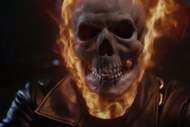Create a free profile to get unlimited access to exclusive videos, sweepstakes, and more!
J.M. DeMatteis looks back at one of the best Spidey stories ever, Spectacular Spider-Man #200

When people talk about great comic book stories, they’re almost always talking about a tale that has played out over a number of issues. That’s the nature of the medium. Comics, especially mainstream superheroes, tend to be serialized across a certain number of issues.
So when you ask people to pick their favorite comics, chances are they’re not going to answer, “Issue No. 3 – 'Hunt The Dark Knight'.” They’re going to say, “The Dark Knight Returns.” They won’t say, “Uncanny X-Men #142;” They’ll answer, “Days of Future Past.”
The great J.M. DeMatteis has written more than his fair share of great stories. Chief among them is “Kraven’s Last Hunt,” one of the all-time great Spider-Man stories. That’s another one that, when people cite it as a favorite, they point to the overall saga (a crossover among the Spidey titles of the era) and rightfully so. It helped elevate mainstream superhero comics to new levels of creative maturity.
But for my money, that’s not his best Spider-story.
That would be Spectacular Spider-Man #200, which is quite simply one of the single greatest issues of Spider-Man ever created. It stands alongside Amazing Spider-Man #33 ("The Final Chapter"), Amazing Spider-Man #122 ("The Goblin's Last Stand), and Amazing Spider-Man Vol. 2 #50 ("Doomed Affairs") as a quintessential Spider-Man tale. SSM #200 is so good, it was one of the few books of the '90s worthy of its foil gimmick cover. It had everything you could want a comic to have: high stakes, a climactic battle between longtime foes, emotional character beats, and a sacrifice that leaves the reader utterly devastated. But most of all, it had what all great Spider-Man stories have: Heart.
“Best of Enemies,” as the story was titled, was the culmination of a nearly two-year exploration into the character of Harry Osborn by DeMatteis and artist Sal Buscema. Despite that, if you picked up issue #200 not having read any of the previous 20+ issues, you would still have received the full impact of the rich, psychologically complex narrative DeMatteis and Buscema crafted.
Once again driven insane by the “Osborn curse” and becoming the Green Goblin, Harry this time was a much more threatening Goblin than his first turn on the glider back in the mid-1970s. That’s because DeMatteis did what all the great Spidey writers do: focused on the characters beneath the masks and let that be the central thrust of the story instead of the super hero stuff.
“Peter Parker is one of the most psychologically and emotionally real characters in the history of comics,” DeMatteis tells SYFY WIRE. “I know him as well as I know some of my best friends. Maybe better because, when I write Peter, I know every stray thought, every conflict, every feeling, wandering through his head and heart.”
Issue #200 of SSM had a cover image of Spider-Man fighting his arch-enemy the Green Goblin, because it was a big round number and Buscema’s typically awesome artwork certainly helped sell extra copies. But the real fight in that story was between two best friends, Peter Parker and Harry Osborn. Harry’s tragic decline back into madness was chronicled in “The Child Within” arc from SSM #178-184. By now, he was seething with rage, and trying to drive his best friend/worst enemy into the same frothing pit of madness that he was in.
When I talked with DeMatteis, I mentioned how he helped make Harry a much more interesting character than he had ever been. I used to just feel sorry for Harry; he had a drug problem, his father didn’t bother to hide his disappointment in him, and his occasional girlfriend Mary Jane couldn’t be bothered with him. But on SSM, DeMatteis fleshed out what being Norman Osborn’s son, as well as being Peter Parker’s closest friend, did to Harry.
“You’ve got two best friends who truly love each other but are also mortal enemies," he says. "If that isn’t a recipe for great drama, what is? Harry and Peter are both very complex people, which meant that while the superhero action played out there was lots of room for psychological and emotional exploration.”
In many ways, DeMatteis saved Harry Osborn as a character. He had spent much of the '80s as one of the least interesting members of Spidey’s supporting cast. It was nice when he and his wife Liz would make an appearance because of the history they have with Peter, but that was it. DeMatteis saw the potential in exploring the demons within Harry. And by doing that, it let him do the same with Peter.
“Harry was more damaged than Peter, but, as we saw in those stories, Peter was sitting on some ferocious personal demons of his own. I loved the push-pull, the emotional tug of war, between those two,” DeMatteis says. “The old cliché is that 'the story wrote itself,' but with two main characters like Peter and Harry, the stories really did.”
Throughout issue #200, Peter is pushed to the breaking point by Harry’s mind games. The connection between the two men behind the masks leaves Spider-Man exposed. One of the many highlights of the book is how prominently Mary Jane fits into the story. During his tenure on Spectacular Spider-Man, DeMatteis portrayed MJ as well as any writer ever has. She wasn’t just the helpless, powerless wife waiting up for her costumed husband. She was his partner.
“Mary Jane is very real to me. There was a depth, a resonance, a reality, to their relationship that I really responded to,” DeMatteis says. “The marriage also provided Peter with someone who knew him better than he knew himself. Someone to bounce off of, share his hopes and troubles with. And vice-versa.”
DeMatteis recognized MJ’s potential — for my money, she’s the best non-super powered character Marvel has — and utilized it in a way that made Peter Parker a more interesting character. Outside of J. Michael Straczynski, no Spidey writer has ever “gotten” Mary Jane as well as DeMatteis did. Issue #200 bore it out. There’s a great scene at the start of the issue where Harry, dressed as the Goblin, grabs MJ and takes her to the Brooklyn Bridge. That of course, is where Harry’s dad killed Gwen Stacy.
But instead of leading us into a traditional tale of “MJ’s in danger, Spidey has to rescue her,” DeMatteis instead delivers a scene where MJ and Harry have a conversation that touches on their own personal history. Instead of making her play the role of hostage, MJ becomes a figure that shows the deep connection between Peter and Harry, and what their conflict has done to everyone they know. DeMatteis says he drew inspiration for his writing from his own marriage.
“The fun of these characters is that we writers pour all the intimate details of our own lives and psyches into them — sometimes consciously, sometimes not,” he says. “And the relationship between Peter and Mary Jane certainly reflected my relationship with my wife. In some cases, word for word! At the same time, the characters are far more than what we put into them. They’re very distinct individuals with lives and minds and hearts of their own. It’s that fusion between the writer’s unique voice and vision and the characters’ unique personalities that makes them come alive in new ways. That certainly happened with Peter and MJ.”
Spider-Man has been blessed with creative dream teams from the beginning. Lee-Ditko, Lee-Romita, Conway-Andru, and JMS-Romita Jr. are just a few that come to mind. DeMatteis-Buscema belong in that upper echelon. Also, as great as DeMatteis’ scripts were, Sal Buscema’s artwork brought it all to life on the printed page.
“The key to a great comic book story is the chemistry between writer and artist. It’s something magical and indefinable and you can’t make it happen, no matter how hard you try,” DeMatteis says. “If the chemistry is off, or isn’t there at all, then the story is going to die. I’ve had stories where I wrote an excellent script, the artist did an equally-excellent job with the visual interpretation, and yet some indefinable element, that chemical click, just wasn’t there — and the story didn’t work. With Sal, that chemistry was there from the first page, first panel, of our collaboration.”
You know from my recent interview with Buscema that I consider “Our Pal Sal” to be one of the all-time great storytellers in comics. Spectacular Spider-Man #200 only confirms that obvious bit of information. As DeMatteis himself says, without Buscema, that comic turns out very differently.
The highlight of that issue for me (and no doubt many others) and why I hold it in such esteem, comes in the final two pages. After planting a bomb in the Osborn Foundation building, meaning to blow up both he and Spider-Man, Harry realizes MJ and his son Normie are still inside. Overcoming a lifetime of doubt and insecurity, Harry Osborn saves the day. He not only saves MJ and his son, but he goes back and saves Peter, too. But the Goblin formula has been slowly draining Harry of life, and his time is running out.
Those last two pages show Peter (in his Spider-Man costume) with Harry in his final moments. There isn't a word of dialogue. The story is told through 13 of the best panels Sal Buscema has ever drawn in his remarkable 60+ year-long comics career. And as DeMatteis explained on his personal website several years ago, that was not the original plan. Here's exactly what he said about that sequence:
“I did everything I could to communicate the power of those last pages to Sal in the plot — along with my thoughts on how the sequence would be handled in the final script. My intention was to verbally milk the pages for all they were worth, wringing out every last drop of emotion; going big and melodramatic via captions, inner monologues from Peter or dialogue between the characters. (Another benefit of 'Marvel style': I didn't have to decide then, I could make up my mind when the art was done.)
Then Sal’s pages came in: It was one of his finest hours. The panel to panel flow was cinematic and crystal clear, the characters dramatic and achingly human. And those final two pages? Perfection! At first — locked into my original vision — I began writing captions and dialogue for the end-sequence, but it quickly became clear that everything I wanted to say had already been said, and better, by Sal. It was all there in the pictures. He had translated my plot so expertly that words would have capsized the sequence and destroyed the emotional power of the moment. So I shut my big mouth and let Harry Osborn die in silence, with his best friend by his side.”
DeMatteis tells me that Buscema elevated his scripts because he was able to capture all the emotions, big or small. “[Sal] is an impeccable storyteller. He can really draw, the emotions are all there on the page,” he says. “Those Spec Spidey stories were very character driven, very emotional — and Sal never failed to deliver on the big moments…the small, the over-the-top action and the intimate connections.
“He gave me whatever I asked for and more," DeMatteis continues. "I don’t know if we’d even be talking about those stories today if Sal hadn’t drawn them. I can’t praise him enough!”
I had been wanting to talk with DeMatteis for a long time, in particular because of his Spidey work. I think a lot of people want to do a deep dive into “Kraven’s Last Hunt” and that’s totally understandable. But for me, Spectacular Spider-Man was his zenith. The industry at the time was a mess and I just didn’t like many of the books being released then. The last comic that I remember being completely obsessed with before I stepped away for a few years was Spectacular Spider-Man.
By 1993, it had become the primary Spidey book, IMHO. And that’s because of the team of DeMatteis and Buscema. Their run had everything I wanted in a webhead book, and if it wasn't for that title, I would have taken my break from comics even sooner. I bring this up to point out that it is absolutely ridiculous that, in an age where Marvel has released an omnibus of the 1980s Muppet Babies comics, that they have not put out a collection of one of the greatest runs in the history of their most popular superhero.
“One of the great mysteries of my career is the fact that the [Spectacular Spider-Man] run hasn’t been collected,” DeMatteis says. “It’s some of my best mainstream work ever, on Marvel’s flagship character, its impact is still being felt today in Nick Spencer’s Amazing Spider-Man run…and yet it still hasn’t been collected? I honestly don’t get it. But I look through the solicitations every month hoping for an announcement. And I’ll keep hoping!"
What do you think is the single greatest Spider-Man comic of all time? Find me on Twitter/Instagram and let me know.
The views and opinions expressed in this article are the author's and do not necessarily reflect those of SYFY WIRE, SYFY, or NBCUniversal.




























